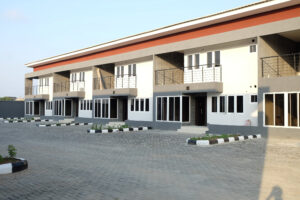Stories
The Need for Sustainable Finance Adoption in Nigeria
Sustainable finance can address both environmental degradation and the growth in housing demand in Nigeria.
Governments in emerging markets must meet the need for affordable housing while balancing urbanization, population growth, limited land access and income inequality. Currently over two billion individuals globally do not have access to pay for decent accommodation. Many of those who will be impacted live in Nigeria and other Sub-Saharan Africa countries, where infrastructure is lagging.
While it’s very much needed, housing development has exacerbated socio-economic and environmental conditions. According to the United Nations Environment Programme and the International Energy Agency, housing is responsible for 35 percent of global energy consumption and 15 percent of greenhouse gas emissions. It’s a “catch 22:” the more we’re likely to close the housing gap, the more we’re likely to deplete natural resources and damage the environment.
In view of the impact of housing on the environment, it’s imperative to encourage developers and finance institutions to push for sustainable finance. Owing to its national policy to address climate change, Nigeria now allows for investments in green securities through the adoption of the global climate bond guidelines by the Securities and Exchange Commission. The issuance of green bonds addresses both environmental degradation and the growth in housing demand.

Alpha Mead, a facilities management group that is entering the affordable residential sector, is starting to bring forward projects for EDGE certification in Nigeria.
As part of Nigeria’s commitment to the SDGs and the United Nations Global Compact to address environmental and social needs, Nigeria was the first African nation to issue a second series climate bond of 15 billion naira (a certified sovereign green bond) in 2019, as well as the fourth nation to issue after Poland, France and Fiji. Nigeria has since 2017 issued more than 25 billion naira as part of the government’s 150-billion-naira green bond program aimed at funding renewable energy and other environmental projects.
In view of the oversubscription of Nigeria’s sovereign green bond issuances, it’s eminent that financial markets can drive sustainable investment opportunities and support developers who are interested in green housing investments.
Institutional investors, particularly pension, insurance and sovereign wealth funds, are viable actors to fill the financing gap for green housing development. Green financing could be further supported by the Central Bank, Ministry of Finance and Federal Inland Revenue Service. They could create tax incentives to allow financial institutions to issue green instruments to proliferate investment in green buildings.
The increasing need for environmental reporting and lowering operational costs has given rise to green building certification systems like EDGE, LEED and Nigeria’s local variant (BEEC).
EDGE estimates the extra costs of going green at 2 to 5 percent, which could be termed a reasonable price to pay in comparison to the long-term benefits of certified green buildings. Added costs are compensated by savings in utilities, maintenance and the better potential of home ownership payback within a 20 to 30-year period.

Construction workers complete concrete pouring into form works at EchoStone’s Peridot Parkland Estate, an affordable housing development in Badagry outside of Lagos.
Innovations like EDGE are helping to create green mortgages, which make it more affordable to own a green home. This is because of a green home’s capacity to generate utility savings, which can more than compensate for a higher loan amount to cover the developer’s extra capex.
Green mortgages also give financiers the opportunity to invest in superior housing developments that are linked to better mortgage rates, which will ultimately provide the critical stimulus needed to redirect the housing industry towards environmentally-friendly buildings.
Green mortgages can be replicated in Nigeria under the current climate bonds program, resulting in a win-win that allows developers to offer homes with less environmental issues, in addition to lower risk for financial institutions and increased benefits for homeowners.
Financial institutions could experience improved lending efficiency, lower risk and better profitability by adopting green lending measures. This will facilitate a higher performance standard for lending with positive implications, such as risk reduction and portfolio growth.
The Central Bank of Nigeria and Ministry of Finance could incentivize green mortgage and infrastructure development through regulations by being flexible in their risk-weighting requirements. The Central Bank could consider reducing the capital that mortgage lenders and financial institutions are required to hold against their mortgage and infrastructure assets if such assets are certified green.
Such regulatory incentives would naturally result in less expensive interest rates for green mortgages and infrastructure as well as deleverage the balance sheet for lenders.
The federal government’s green bonds initiative has paved the way for institutions that are willing to ride the sustainable finance train to raise funding that benefits the environment as well as meets the income projections of their stakeholders.

